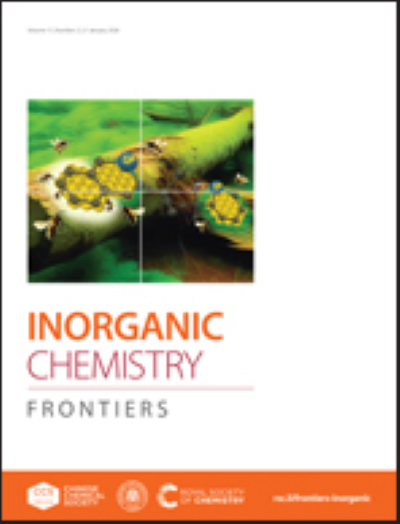含富电子邻菲罗啉n杂环亚胺取代基:合成、光学性质、金属配位
IF 6.1
1区 化学
Q1 CHEMISTRY, INORGANIC & NUCLEAR
引用次数: 0
摘要
具有给π基团的多吡啶是一类富电子配体,在配位化学和催化方面具有重要意义。然而,强碱性胍基取代基的掺入通常会引入多个结合位点,配位通常有利于胍基氮原子。在此,我们报道了一种新的富电子1,10-菲罗啉配体的合成和表征,该配体具有大块的NHI基团,定义了结构良好的配位腔。质子化研究和锌(II)配合物的制备表明,刘易斯酸优先配位在菲罗啉氮原子上,而不是在NHI部分。通过计算和实验相结合的方法研究了新配体及其配合物的电子和光物理性质,表明其发射和吸收特性对质子化、浓度和金属配位高度敏感。本文章由计算机程序翻译,如有差异,请以英文原文为准。
Electron-rich phenanthroline bearing N-heterocyclic imine substituents: synthesis, optical properties, metal coordination
Polypyridines functionalized with π-donating groups constitute a class of electron-rich ligands with significant relevance in coordination chemistry and catalysis. The incorporation of strongly basic guanidinyl substituents, however, often introduces multiple binding sites, with coordination typically favoring the guanidyl nitrogen atoms. Herein, we report the synthesis and characterization of a new electron-rich 1,10-phenanthroline ligand featuring bulky NHI groups that define a well-structured coordination cavity. Protonation studies and the preparation of a zinc(II) complex reveal that Lewis acids preferentially coordinate at the phenanthroline nitrogen atoms rather than the NHI moiety. The electronic and photophysical properties of the new ligand and its complexes are explored through a combination of computational and experimental methods, demonstrating that its emission and absorption characteristics are highly sensitive to protonation, concentration, and metal coordination.
求助全文
通过发布文献求助,成功后即可免费获取论文全文。
去求助
来源期刊

Inorganic Chemistry Frontiers
CHEMISTRY, INORGANIC & NUCLEAR-
CiteScore
10.40
自引率
7.10%
发文量
587
审稿时长
1.2 months
期刊介绍:
The international, high quality journal for interdisciplinary research between inorganic chemistry and related subjects
 求助内容:
求助内容: 应助结果提醒方式:
应助结果提醒方式:


